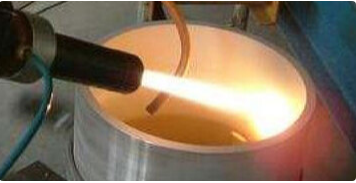

current position:Information and data>thermal spray material
Metals and alloys are the most widely used and most diverse materials in thermal spraying, and are essential materials for thermal spraying. Because metals are mostly ductile, they can be made into powders or wires. A variety of desired physical and chemical properties can be obtained by transforming the composition of elements in the alloy.
1. Aluminum, zinc and alloys
Aluminum and zinc, and their alloys, are the first thermal spray materials to be used, initially they were used for fuse-line spraying. After the emergence of powder spraying methods, powder materials have also emerged.
Both aluminum and zinc are more active elements than iron in their electrodynamic sequence, so they are widely used in anti-corrosion coatings for steel components, which can resist atmospheric corrosion, and can also be used as sacrifice anodes, which can act as electro-active elements for steel substrates. Chemical screening. Through seawater immersion experiments on aluminum coatings abroad, it has been confirmed that its seawater corrosion resistance is good. After 6 years of seawater immersion, almost no corrosion is found. Aluminum and zinc coatings, if further sealed, will have improved corrosion resistance.
2. Copper and copper alloys

High-purity copper can be made into conductive coatings and artistic decorative coatings (such as spraying for sculpture). Adding a small amount of iron, nickel and manganese elements to aluminum bronze has good corrosion resistance, especially seawater corrosion resistance. It is insoluble in sulfuric acid and hydrochloric acid, but easily soluble in nitric acid. Grinding performance is also very good. Phosphor bronze has good wear resistance and can be used for wear-resistant coatings of bearings. Phosphor bronze coatings are beautiful and light, so they can also be used for decorative coatings.
3. Molybdenum
The purity of molybdenum used for spraying is more than 99.95%, and it can be either wire or powder. Due to the good joint performance between molybdenum and steel materials, it is often used as a primer material. Molybdenum coating also has good wear resistance, and molybdenum is still the only metal that is resistant to heat-resistant concentrated hydrochloric acid.
4. Nickel and Nickel Alloys
Pure nickel has good corrosion resistance and is the best metal material for heat-resistant concentrated lye corrosion, but it is not resistant to oxidizing acid.
Nickel-chromium alloys are widely used wear-resistant and corrosion-resistant materials. They have good acid resistance, alkali resistance, and good heat resistance. Their wear resistance increases with the increase of chromium and carbon content.
The alloy of nickel and copper and a small amount of other elements is called Monel alloy, which has good corrosion resistance, oxidation resistance, corrosion resistance to salt water and corrosion resistance in neutral or alkaline salt solutions. It has good corrosion resistance to non-strong oxidizing acids, but it is prone to corrosion when in contact with iron.
5. Self-fluxing alloys
Self-fluxing alloys refer to superalloys formed by adding more than 1.5% boron and silicon elements in iron-based, nickel-based or cobalt-based. After adding boron and silicon, the melting point can be lowered and the fluidity can be increased. At the same time, the affinity with boron, silicon and oxygen is greater than the affinity between metal components and oxygen. When melting, they can distinguish and generate boron oxide and silicon oxide with oxygen. On the surface of the coating, a non-porous coating is formed after cooling, and the metal component forms a metallurgical bonding layer with the surface of the substrate. This is the material that must be used for the spray welding process described above.
The three typical types of self-fluxing alloys are iron-chromium-boron-silicon series, nickel-chromium-boron-silicon series and cobalt-chromium-tungsten series.
Iron-based alloys have good wear resistance and certain corrosion resistance, and are widely used in wear-resistant coatings for individual mechanical parts because of their low cost.
Layer and repair the whole machine. Its hardness range is determined by the chromium content and carbon content, generally in HRC25 ~ 60 or higher.
Nickel-based alloys not only have good wear resistance, but also have good corrosion resistance and good red hardness. It is widely used in parts that require both corrosion resistance and wear resistance. Such as valve sealing surface, plunger surface, thermocouple conduits used in corrosive media and chemical containers that require corrosion resistance.
The biggest feature of cobalt-based alloys (stellite alloys) is that they have outstanding corrosion resistance and wear resistance at high temperatures, and have good cavitation resistance, so they can be used in high-temperature exhaust valves, high-temperature and high-pressure valves, high-temperature molds, and steam turbines. Repair or pre-protection of leaves, etc.
Self-fluxing alloys are specially produced for the spray welding process, but they can also be used directly in the spraying process, however the materials used for the spraying process are not necessarily suitable for the spray welding process.
Hot information

